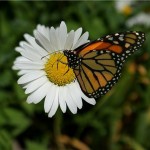A weed is a plant growing where you don’t want it. That’s what unhealthy postural habits and other unwanted habits are like. Weeds aren’t necessarily bad, they’re just not helpful in your garden or your lawn. They take over everything, and if you don’t pull them out by the roots, they just keep coming back. The things that we do habitually aren’t necessarily bad, either; as a matter of fact, habits are one way that we learn. They are ways that we learn to respond to anything and everything, including unconscious patterns of tension, ways of holding ourselves and ways of moving.
Let’s say we have noticed that we have a way of standing or sitting that we don’t like, or more often, we notice stiff shoulders and neck, a sore back or tiredness that we don’t realize are related to the way we stand or sit, because that way feels normal to us. That’s the weed in our garden that we’d like to get rid of. So we do something about the stiffness and pain, like taking an analgesic, exercise, massage, physical therapy, rest. There’s nothing wrong with any of those things, but if we go about it in our habitual way, with our habitual way of holding ourselves, nothing will change. We might have lopped off the weed for the moment, but it grows back up. The stiffness and soreness comes back. And the longer we continue to operate in that habitual way, the more ingrained it becomes.
So how do we get to the root? The first thing we can do is simple: just stop. Well, stopping isn’t always quite so simple, as anyone who has tried to get rid of a habit can tell you. But think again of the weed. We’re walking across the lawn and we come upon a weed. Instead of just grabbing it and yanking, first let’s stop, take a look at the weed, breathe, and then just take stock of ourselves. What?, you say, I look at myself and not the weed? Exactly. This is pretty much where my weed analogy ends, because it is by paying attention to ourselves IN activity that the weed starts to disappear from the roots. By shifting the focus of our attention from the weed to how we use ourselves, we begin to create a fundamental change in the way we use ourselves.
I’m not saying it happens over night, but by applying the principles that F.M. Alexander taught—saying no to habitual reactions of tension and “directing” ourselves—when we think to look again, there are fewer weeds in our garden.
What does this have to do with how we sit and stand? Those are habitual, learned reactions that as much as we try to “correct” them, we just keep falling back into the same patterns. So try this: start small and don’t try to figure out if you’re doing it “right” or not. Right now, as you’re sitting there, stop and observe yourself and how you are “using yourself” in this moment. It’s not easy to see if we’re not used to thinking about it in this way, but classes with an Alexander Technique teacher can help you learn to improve your use of yourself as you go about your activities.



Recent Comments